Fred B. Bercovitch, Matt J. Kessler
The environmental enrichment program of the Caribbean Primate Research Center is guided by an evolutionary and ecological perspective. The evolutionary perspective suggests that primates should be housed in enclosures that provide a social and physical environment that resembles their natural surroundings as much as possible.
The ecological perspective emphasizes the use of recycled products as enrichment devices as a way of decreasing the environmental degradation affecting the habitat of wild primates and increasing the preservation of their natural habitat.
Key word index: environmental enrichment, recycled material, primates
The foundation of the Environmental Enrichment Program of the Caribbean Primate Research Center [CPRC) is built upon two pillars: (1) the psychological well-being of primates is enhanced by residing in a physical and social environment that mimics their natural situation in the wild as much as possible, and (2) enclosure configuration and enrichment devices should be based upon conserving natural resources and using recycled materials as much as possible. These dual aspects combine environmental enrichment for captive populations with environmental preservation for wild populations.
PRIMATE FACILITIES
The CPRC operates two research facilities for live primates. One facility is a 38 acre island, Cayo Santiago [CS], off the southeast coast of Puerto Rico that is home to about 1200 rhesus macaques.
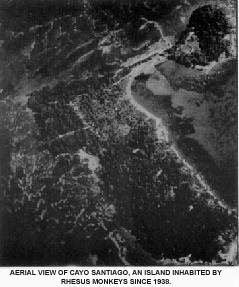
This research site was initiated in 1938 with the introduction of about 400 monkeys and has maintained continuous behavioral and demographic records since 1956 (Sade et al., 1985; Rawlins & Kessler, 1986). The second site is the 410 acre Sabana Seca Field Station [SSFS], located about 15 km west of San Juan in the midst of a subtropical forest. This facility houses rhesus and pigtail macaques, as well as patas monkeys. The monkeys at the SSFS reside in social groups containing between ten and 150 individuals depending upon whether they are housed in an outdoor cyclone fence pen or one of the larger one to two-acre corrals. We restrict the use of single cages to temporarily quarantine monkeys for veterinary care or conditioning. All singly-housed monkeys are maintained in areas where visual, olfactory, and auditory signals can be exchanged with conspecifics and where they have a view of the adjacent forest.
ENVIRONMENTAL GOALS
Our primary goal of mimicking nature is based upon the reasoning that evolutionary modifications generated over the millions of years of primate evolution have produced individuals that are adapted to live in a particular social and physical environment. For rhesus macaques, the primary species housed at the CPRC, this entails residing in social groups. However, one unavoidable consequence of living in a social group, is that agonistic interactions will occur. Such aggression can range in intensity from a mother disciplining her infant to fights among individuals. Given the expectation that social life will entail agonistic interactions, we have sought various means of replicating the natural situation while reducing potential sources of friction among animals.
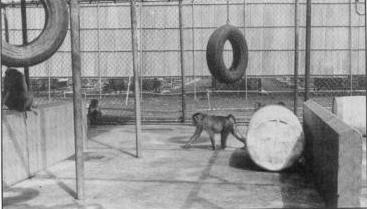
For example, stable social hierarchies appear to be one mechanism adopted by primates to minimize aggressive encounters (Bernstein & Gordon, 1974), and primates appear to be under more stress under times of social instability than when conditions are stable. Our environmental enrichment program attempts to maintain troop stability by introducing animals into a group as rarely as possible. Most outbreaks of severe aggression in cercopithecine primates occur either when groups are first formed (Bernstein, 1969; Fairbanks et al., 1978) or when strangers are introduced into a group (Southwick, 1967; Kaplan et al., 1980; Kessler et al., 1985). We are currently involved in a research project aimed at screening animals for various endocrine and neurobiological parameters that might assist us in transferring animals between groups when this type of action is necessary.
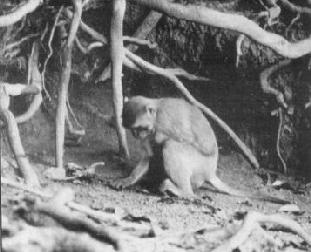
A rhesus monkey eating the soil on Cayo Santiago.
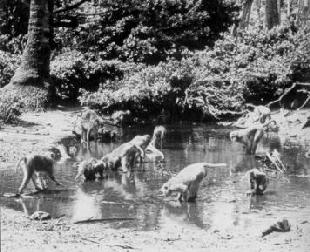
Monkeys drinking the water from one of the small ponds that periodically form on Cayo Santiago.
A second facet to our program is to ensure that all enclosures have potential places of refuge so that lower ranking animals can try to escape from higher ranking conspecifics. However, these places of refuge must have an escape route or the subordinate individual may be trapped inside by a dominant individual and not be able to escape his or her wrath. One of the ways that we provide refuge to the animals is by placement of numerous barriers in an enclosure that essentially provide an obstacle course that must be navigated during a chase. For example, monkeys housed in the outdoor pens have mobile 55 gallon drums and one meter tall cement perches that provide visual and physical barriers for protection from escalated aggression.
The mobile drums can also act as a small tunnel when both ends are removed.
In what might seem paradoxical at first, we enhance the psychological well-being of primates by limiting veterinary intervention to those cases where wounds are non-superficial. Veterinary care involves isolation and capture of individuals, which cannot only be disruptive and stressful to the members of the group, but can cause further injury. Minor wounds left untreated can cause less trauma for the animals than if the same wounds are treated after the individuals have been removed from their home environment. Individuals are monitored on a daily basis, and if wounds are not healing properly on their own, then remedial action is taken. When housed with conspecifics, grooming is oftentimes aimed at the site of surface wounds. The monkeys have amazing recuperative abilities and do not seem to suffer from minor wounds. On the other hand, reintroduction of monkeys who are removed for treatment has resulted in attacks upon the monkey because of social structural rearrangements that have occurred during the injured monkeys absence. Our rule of thumb is to use human beings as models for primate veterinary treatment; many open wounds among children are left untreated and we care for group-housed monkeys in a similar manner. It is important to realize that the veterinary care program of the CPRC has been approved by both NIH and the USDA, and the CPRC is fully accredited by the American Association for Accreditation of Laboratory Animal Care (AAALAC).
The policy adopted for the enclosed primates is based upon the half century of observations of free-ranging rhesus macaques at Cayo Santiago. This island research facility effectively mimics the natural environment of rhesus macaques and provides the yardstick by which we evaluate the health and well-being of the monkeys at the SSFS. For example, the monkeys on Cayo Santiago are provisioned with monkey chow, but spend about half of their feeding time ingesting the natural vegetation and soil (Marriott et al., 1988).
Most of the monkeys at the SSFS are housed in large outdoor enclosures where they supplement their diet with the grass growing inside the corral. Fruits are provided to the monkeys as often as possible by using natural fruits that grow at the SSFS and elsewhere in Puerto Rico.
Another facet of the Cayo Santiago rhesus facility that we have tried to replicate is the monkeys' penchant for swimming (Chance, 1956). Because of rainfall patterns on the island, periodic inundation of low areas produces temporary large ponds. The immature monkeys will climb the 20 meter tall palm trees and leap into the puddles as one component of their playfulness. Groups of monkeys have also been observed swimming in the shallow sea water surrounding the island! The monkeys also congregate around these ponds for resting and drinking.
We have provided many of the monkeys at the SSFS with portable swimming pools that not only provide them with a place to play, but also an area for cooling off during the hot and humid summer months. Although one federal agency has no problems with the temporary swimming ponds at Cayo Santiago, the CPRC has been forced to drain the ponds by another federal agency that viewed these ponds as unhealthy. The consequence of this action has been to deprive the monkeys of an enjoyable play area. Guidelines for primate welfare are often written by veterinarians trained in domestic animal husbandry, but lacking an adequate background in behavioral primatology, evolutionary biology, and natural history. As a consequence, species-specific needs of primates are frequently undermined by promulgating and enforcing animal welfare criteria that are not particularly apt for primates.
USING RECYCLED MATERIALS FOR ENRICHMENT DEVICES
The second major goal of the environmental enrichment program of the CPRC is based upon minimum environmental impact on the natural habitat of wild primates. The number of primate species in the wild is rapidly dwindling as a result of deforestation and destruction of the natural habitat (Mittermeier & Cheney, 1987), so we have sought to enrich the environment of captive primates by aiding in attempts to preserve the natural environment of wild primates. One means of achieving this goal is to use resources that are considered waste products by various companies. For example, we have deployed large wooden telephone spools that are bereft of cables in the big outdoor enclosures.
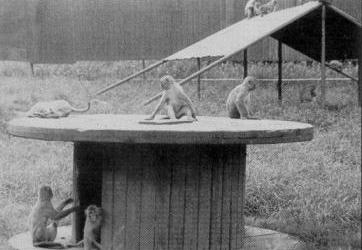
The monkeys use the spools for resting, playing, feeding, grooming, mating, and shelter (Bercovitch et al., 1990). Similarly, we have attached old, discarded tires to chain links and suspended them from the closed enclosure ceilings to be used as swings.
To fully expand upon our environmental perspective, we have begun constructing entire enclosures from recycled plastic.
Large cages (8 ft x 8 ft x 8 ft) were fabricated from 100% recycled co-mingled plastics or 60% recycled PVC. The plastic modules are strong, durable, non-toxic, and light-weight They are easily cleaned and sanitized, as well as being mold-resistant, insect-proof, and UV-light stabilized. The lack of metal components in the cages completely eliminates rust, corrosion, and the potential for zinc toxicity.
Another means of achieving the minimal ecological destruction goal was the placement of PVC "hutches" in some of the large outdoor enclosures.
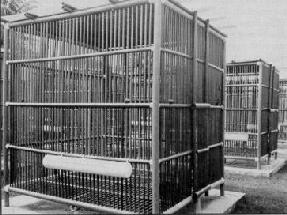
An outdoor enclosure fabricated from recycled material

Rhesus monkeys in a large corral atop one of the defective PVC conduits that have been modified into "Hutches."
These quonset hut-like structures, which we call "monkey cabanas", provide the animals with the same benefits as the telephone spools. We obtain defective 36" and 48" diameter, thick-walled pipes from a local manufacturer that would be unusable for their intended purpose and horizontally cut them in order to make the hutches.
Environmental enrichment in primate facilities need not jeopardize research, and can be implemented in multiple ways, (e.g. Segal, 1989; Brent, 1992; Reinhardt & Reinhardt, 1992). The CPRC was created as a research facility, not a breeding facility, but our minimal intervention policy has resulted in a surplus of monkeys that can be made available to other primate facilities. We have built our environmental enrichment program on a foundation of ecology and evolution by mimicking the natural environment and by preserving natural resources as much as possible. We suggest that conservation biology can be a foundation for the psychological well-being of both captive and wild primates.
ACKNOWLEDGEMENTS
The CPRC is funded by grants from the University of Puerto Rico Medical Sciences Campus, the Commonwealth of Puerto Rico, and NIH Grant RR03640. The facilities are fully accredited by the American Association for Accreditation of Laboratory Animal Care [AMLAC), and meet or exceed the NIH standards set forth in the "Guide for the Care and Use of Laboratory Animals". We appreciate the assistance and advice of John Berard, Jose Rodriguez, Pablo Nieves, and Hector Martinez in developing and implementing the CPRC Environmental Enrichment Program.
REFERENCES:
Bercovitch, F. B., Tena-Betancourt, E., Kessler, M. J., & Lebron, M. R. (1990). A multi-functional environmental enrichment device for primate enclosures. Laboratory Primate Newsletter, 29,16-17.
Bernstein, I. S. (1969). Introductory techniques in the formation of pigtail monkey troops. Folia Primatologica, 10, 1-19.
Bernstein, I. S., & Gordon, T. P. (1974). The function of aggression in primate societies. American Scientist, 62, 304-311.
Brent, L (1992). Enriching the lives of captive primates. Humane Innovations and Alternatives, 6, 371-373.
Chance, M. R. A. (1956). Social structure of a colony of Macaca mulatta. British Journal of Animal Behaviour, 4, 1-13.
Fairbanks, L A., McGuire, M. T., & Kerber, W. (1978). Effects of group size, composition, introduction technique and cage apparatus on aggression during group formation. Psychological Reports, 42, 327-333.
Kaplan, J. R., Manning, P., & Zucker, E. (1980). Reduction of mortality due to fighting in a colony of rhesus monkeys (Macaca mulatta). Laboratory Animal Science, 30, 565-570.
Kessler, M. J., London, W. T., Rawlins, R. G., Gonzalez, J., Martinez, H. S., & Sanchez, J. (1985). Management of a harem breeding colony of rhesus monkeys to reduce trauma-related morbidity and mortality. Journal of Medical Primatology, 14, 91-98.
Marriott, B. M., Roemer, J., & Sultana, C. (1989). An overview of the food intake patterns of the Cayo Santiago rhesus monkeys (Macaca mulatta): report of a pilot study. Puerto Rico Health Sciences Journal, 8, 87-94.
Mittermeir, R. A., & Cheney, D. L. (1987). Conservation of primates and their habitats. In B. B. Smuts, D. L. Cheney, R. M. Seyfarth, R. W. Wrangham, & T. T. Struhsaker (Eds.), Primate societies (pp. 477-490). Chicago: University of Chicago Press.
Rawlins, R. G., & Kessler, M. J. (1986). The history of the Cayo Santiago colony. In R. G. Rawlins & M. J. Kessler (Eds.) The Cayo Santiago macaques (pp. 13-45). Albany, NY: SUNY Press.
Reinhardt, V., & Reinhardt, A. (1992). Quantitatively tested environmental enrichment options for singly-caged nonhuman primates: a review. Humane Innovations and Alternatives, 6, 374-384.
Sade, D. S., Chepko-Sade, B. D., Schneider, J. M., Roberts, S. S., & Richtsmeier, J. T. (1985). Basic demographic observations on free-ranging rhesus monkeys. New Haven, CT: Human Relations Area files.
Segal, E. (Ed.). (1989). Housing, care and psychological well-being of captive and laboratory primates. Park Ridge, NJ: Noyes Publications.
Southwick, C. H. (1967). An experimental study of intragroup agonistic behaviour in rhesus monkeys (Macaca mulatta). Behaviour, 28, 182-209.
Reproduced with permission of the editor. Published in Humane Innovations and Alternatives Vol. 7, 1993, p.435-438.